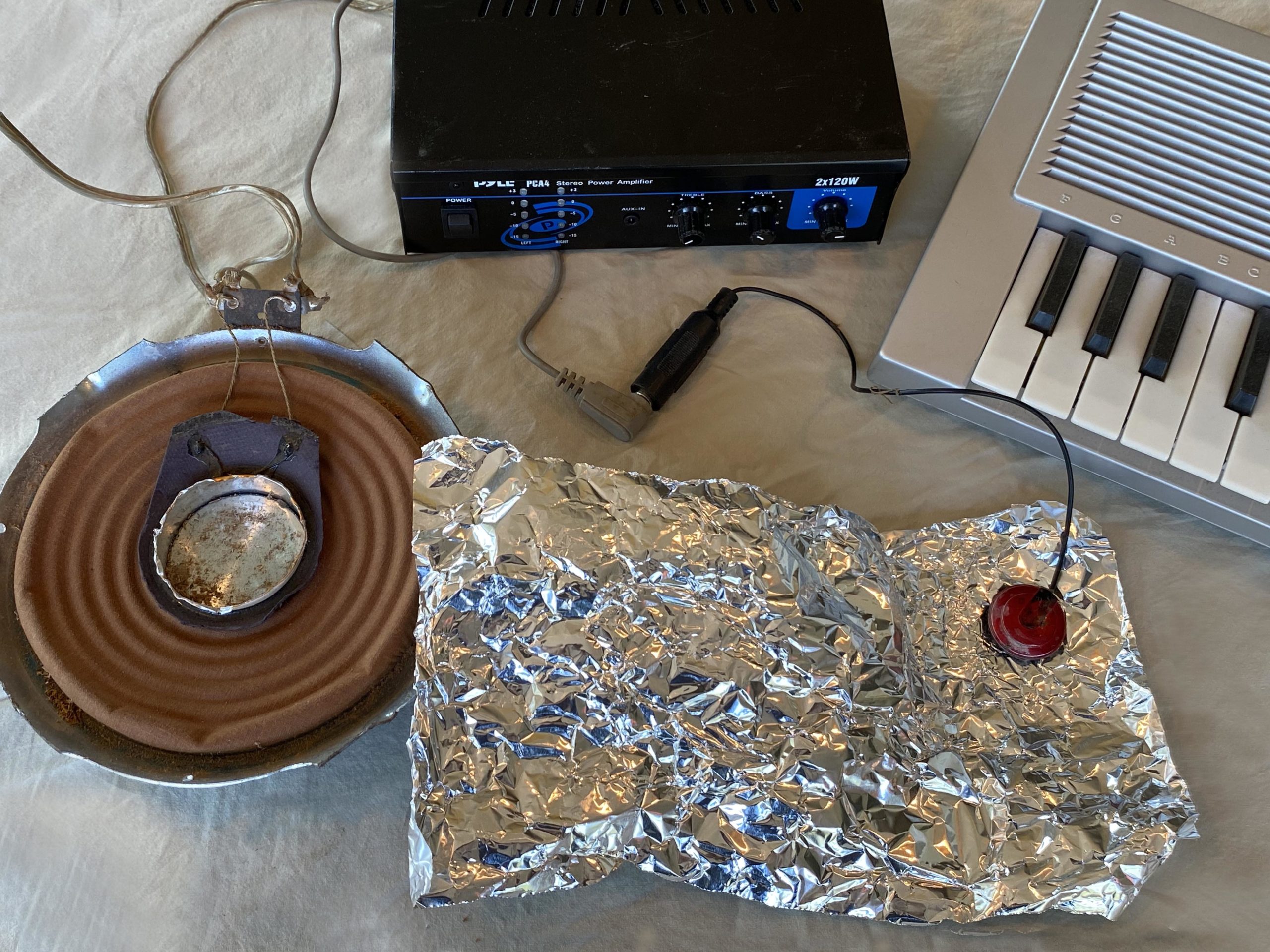
The components in the photo on this page make up a musical instrument called the Speaker Driver Instrument. The elements of it, you can see, are an inexpensive little electronic keyboard, a stereo amplifier, a speaker driver minus its speaker cone, and a scrap of tinfoil with a piezo on it. You can hear the sound of in the clip above, and I’ll explain its workings in this essay.
The heart of a typical loudspeaker is a the voice coil, attached to a “chassis” that helps to align it. These components are electromagnetically driven to go back and forth in a pattern that reproduces the frequencies of the musical signal the speaker receives from an amplifier. Attached to the chassis is a diaphragm, the speaker cone. The cone provides a larger surface so that the sound patterns, as manifest in the movement of the coil and chassis, radiate out into the air and can be heard.
This kind of loudspeaker is the central element in the speaker driver instrument I’m now describing. To make the instrument, the first step is to remove the cone from a speaker. The coil and chassis will then still reproduce the sound patterns from the amplifier, but much more quietly. You can then hold something like a piece of tinfoil against the moving chassis to get sounds that are crazy rattly distorted, but which still reflect the frequencies and rhythms and patterns of the original music.
I’ll get into more detail on all this in a moment, but first, some history.
The idea of using a stripped-down loudspeaker in this way first dawned on me in connection with ruminations on some seemingly very different instruments. In an attempt to get down to first principals, I had asked myself this question: what’s the simplest way I can come up with to force something to happen at controllable frequencies in the hearing range? This line of thought eventually led me to the instrument called Savart’s Wheel, in which a forced vibration is achieved mechanically/acoustically/non-electronically by means of controlled scaping or rasping. Note that this sort of forced vibration, in which the frequency is determined mechanically, is quite different from what happens in most acoustic instruments, where something vibrates at its own natural frequency by means of the natural springy qualities of the material. Returning to in my ruminations about forced vibration, it crossed my mind that forced vibration is also what a speaker does when fed an audio signal: the piston is forced to oscillate at the frequencies dictated by the signal.
With this in mind, I found a big heavy powerful speaker — an old one that no one would likely have any further use for — and tore out the paper cone, leaving just the driver (the voice coil and chassis) at the center. I hooked it up through an amplifier to a little electronic keyboard. And I then began messing around. The idea was to play notes on the keyboard while pressing various materials loosely against the chassis in search of interesting sounds. As mentioned above, I discovered that tinfoil works great; it proved to be my favorite. But along the way I tried many other candidates – thin pieces of plywood, lightweight pieces of sheet metal, pieces of paper or cardboard – and I found that cool sounds can be had with almost anything.
This secondary surface, the tinfoil or whatever else it might be, serves the same purpose as the missing speaker cone: it provides the needed surface area to project the sound out into the air. But there are two notable differences between the original speaker cone and the new secondary surface:
1) The original cone is carefully designed to not add any of its own resonances or biases into the sound. The material the new surface, on the other hand, is full of such biases, and they very much affect the tone.
2) The way the chassis hammers against the surface makes a big difference in the sound. This, too, is a very different situation from the original speaker cone which moved smoothly along with the driver.
The playing technique that evolved consists of using one hand to play the keyboard and the other hand to hold the tin foil or whatever against the driver. I found that the way you make the contact between the surface and the chassis — where the surface touches the chassis, how hard it touches, the angle, and so forth — makes a big difference in the resulting sound. You can get many expressive effects by varying this contact.
I soon developed a way to take the instrument to a new level of craziness. I found that you can get even more outrageous sounds if you attach a piezo pickup to the tin foil and amplify the signal from the piezo. This makes things more complicated, because now you need two amplifiers: one for the original signal sent from the keyboard to the speaker driver, and another for the final signal coming from the piezo. I used two separate amplifiers just because that was convenient with the equipment I had on hand, but another maker might choose to use a single stereo amplifier instead.
And that’s the natural history of the speaker driver instrument. The idea thus far been only minimally explored; I hope that, should others explore it further, it will continue to prove promising and productive.
